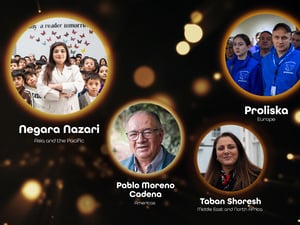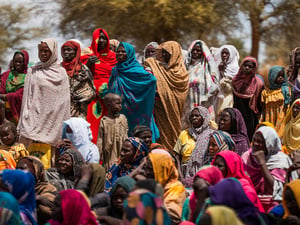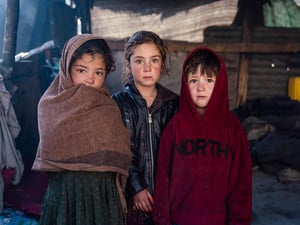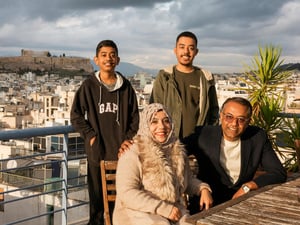Europe
Europe

Regional overview
Europe remains a major host of forcibly displaced and stateless people, with more than 20 million by the end of 2025, including 5.2 million refugees from Ukraine. UNHCR works to ensure protection, inclusion, and empowerment for these populations, but the outlook for 2026 is shaped by persistent protection risks, severe financial constraints, and rising anti-refugee sentiment across many countries.
Since February 2022, over 6.8 million refugees have fled Ukraine, while millions remain displaced inside the country. Most refugees intend to return home eventually, but insecurity, attacks on civilians and infrastructure, and lack of housing and livelihoods prevent many from doing so. Host countries continue to provide protection under the EU’s Temporary Protection Directive, which remains in force until March 2027, though challenges persist for people with specific needs. UNHCR and partners will maintain urgent assistance and protection inside Ukraine and in neighboring countries through the Regional Refugee Response Plan, including winterization efforts to help vulnerable families amid energy shortages and ongoing attacks.
Beyond Ukraine, mixed movements of refugees and migrants along sea and land routes toward Europe continue, despite declining arrival trends. Restrictions on access to territory and asylum, violent pushbacks, and deterrence measures undermine core protection principles. UNHCR has welcomed the EU Pact on Migration and Asylum as an opportunity to improve management of mixed movements, while emphasizing the need to uphold fundamental rights, including access to territory and asylum for those in need of international protection.
Ongoing emergencies in Europe
Text and media 6
Ukraine emergency
In response to the massive humanitarian crisis caused by the ongoing full-scale war in Ukraine, UNHCR is working with national authorities, UN agencies, displaced communities and local and international partners to provide urgently needed assistance.
What role does UNHCR play in Europe?
As the custodian of the 1951 Refugee Convention, UNHCR works to safeguard the rights and well-being of refugees, asylum-seekers and stateless persons by providing guidance and support to governments across Europe and promoting the best international standards in legislation, policy and procedures.
UNHCR will continue supporting States to address persistent protection challenges across Europe, emphasizing the need for robust partnerships, timely data, and flexible, diversified funding. Following more than 14 years of conflict in Syria, voluntary returns surged in late 2024, with over 509,000 Syrians repatriating from Türkiye to Syria by September 2025, bringing the total since 2016 to 1.25 million. UNHCR has monitored more than 360,000 returns to ensure voluntariness and informed decision-making. To strengthen national mechanisms for safe and dignified returns, UNHCR and Türkiye’s Presidency of Migration Management launched a three-year EU-funded initiative.
Local and community-based organizations remain essential to advancing refugee protection and inclusion. UNHCR works with municipal networks to promote refugee participation and ensure responses are rooted in local realities. However, severe funding shortfalls have drastically impacted UNHCR’s presence and assistance. By October 2025, less than half of financial requirements for Europe were met, leading to devastating consequences: in Moldova, negative coping strategies among refugee households rose from 60% to 80% after cash support cuts; in Türkiye, nearly 50,000 refugees lost access to essential services due to community center closures; and in Greece, reductions in legal aid and mental health services left thousands without critical support.
UNHCR’s priority for 2026 is to safeguard protection, inclusion, and resilience initiatives through partnerships with governments, municipalities, and local actors. Flexible and predictable funding remains essential to sustain life-saving efforts, strengthen social cohesion, and maintain regional stability—making investment in protection not only a humanitarian imperative but also a cost-effective strategy to reduce aid dependency and foster long-term resilience.
What is the difference between a refugee, an asylum-seeker and a migrant?
People who are forced to flee their country in fear of persecution are refugees. They have legal protections under the 1951 Refugee Convention and its 1967 Protocol, as well as other legal instruments. UNHCR, governments and humanitarian organizations offer assistance to refugees, who are recognized by State authorities or UNHCR, because it is too dangerous for them to return home. Asylum-seekers are people whose request for refugee status, or asylum, is being processed.
People who move to a different country primarily to improve their lives by finding work or gaining education, or to reunite with family, are known as migrants.
This distinction is important. States interact with refugees through specific norms dealing with refugee protection and asylum defined in regional and international frameworks.
How many refugees have arrived in Europe?
See our Operational Data Portal for the Ukraine Refugee Situation for the latest numbers on refugee movements related to the Ukraine emergency.
For up-to-date numbers of people arriving in Europe via the Mediterranean and Northwest African maritime routes, as well as the numbers of people who have died or gone missing after attempting to cross the sea, please see our Operational Data Portal for the Mediterranean Situation.
You can find more statistics and data visualizations on the numbers of refugees and asylum-seekers in Europe on our Figures at a glance page, Eurostat, the EU’s statistical office, and in the latest UNHCR Global Trends Report.
Where can I find statistics and information about refugees and asylum-seekers arriving in Europe?
UNHCR maintains a public database of statistics on refugees and asylum-seekers in Europe and around the world. It has also developed a mobile application for iOS and Android. Each year, we publish a Global Trends report, an authoritative overview of the world’s refugees, asylum-seekers, internally displaced people and stateless persons.
In addition, data on specific situations in Europe can be found on dedicated operational portals (Ukraine, Mediterranean and South Eastern Europe).
Access the database for more statistics
Who are UNHCR’s partners in Europe?
As per its mandated responsibilities and in line with the Global Compact on Refugees, UNHCR engages with a wide range of stakeholders to pursue its protection and solutions priorities in Europe. These include governments, international organizations within and outside the UN system, other humanitarian and development actors, regional actors (notably the European Union and its agencies, the Council of Europe, and the Organization for Security and Co-operation in Europe), local authorities, municipalities, academia, the private sector, media, and civil society, including refugee-led and faith-based organizations. Refugees, other forcibly displaced, and stateless persons are key partners, and we have been strengthening our engagement with refugee-led organizations.
In collaboration with the International Council of Voluntary Agencies (ICVA), we organize regular regional dialogues and bi-annual consultations with civil society actors to identify opportunities for joint and complementary advocacy.
UNHCR is committed to supporting the realization of the 2030 Sustainable Development Agenda and its Sustainable Development Goals. In Europe, UNHCR is an integral part of the regional UN system and co-chairs the Issue-Based Coalition on Large Movements of People, Displacement and Resilience.
Four of our offices in Europe are accredited to regional institutions (the Council of Europe, the Organization for Security and Co-operation in Europe, the European Union Agency for Asylum, and Frontex).
Key publications
Population and financial overview
How do I get in touch with UNHCR?
The best way to contact us is via our website.
How do I locate a spokesperson who can tell me more about UNHCR’s work in Europe or the world?
Contact UNHCR spokespeople at our headquarters in Geneva or in many of our country offices worldwide for media enquiries and interviews.
If I am an asylum-seeker or refugee in Europe and need help or advice, what should I do?
You can use the Help website in some countries, or contact UNHCR or one of its partners directly in the country where you are.
If I want to work for UNHCR, what should I do?
You can find available job openings, internships and other opportunities on the UNHCR careers page and on the UNHCR's country-specific and regional websites. There are also opportunities to volunteer with UNHCR and its partner organizations.
How can I contribute to and support UNHCR’s work?
UNHCR relies almost entirely on voluntary contributions from governments, UN and pooled funding mechanisms, intergovernmental institutions and the private sector, as well as individual donations. We encourage these funds to be allocated as flexibly as possible to enable us to assist where the needs are the most acute by providing protection, shelter, water, health, education and other essential support to refugees, asylum-seekers, stateless persons and internally displaced people across the region.
UNHCR’s website contains information on how to contribute financially. Donations can also be made to individual refugee-hosting countries through our private sector partnerships and also to specific emergencies.
Stay informed with the latest reports and updates on UNHCR’s work in Europe
Read the latest reports and publications, including the region's quarterly updates and fact sheets.
Find the latest data and statistics on refugees and other displaced persons.
Stay up to date on emergencies and our work in Europe.
Find out about the importance and benefits of engaging in, and championing, locally led action across Europe.















